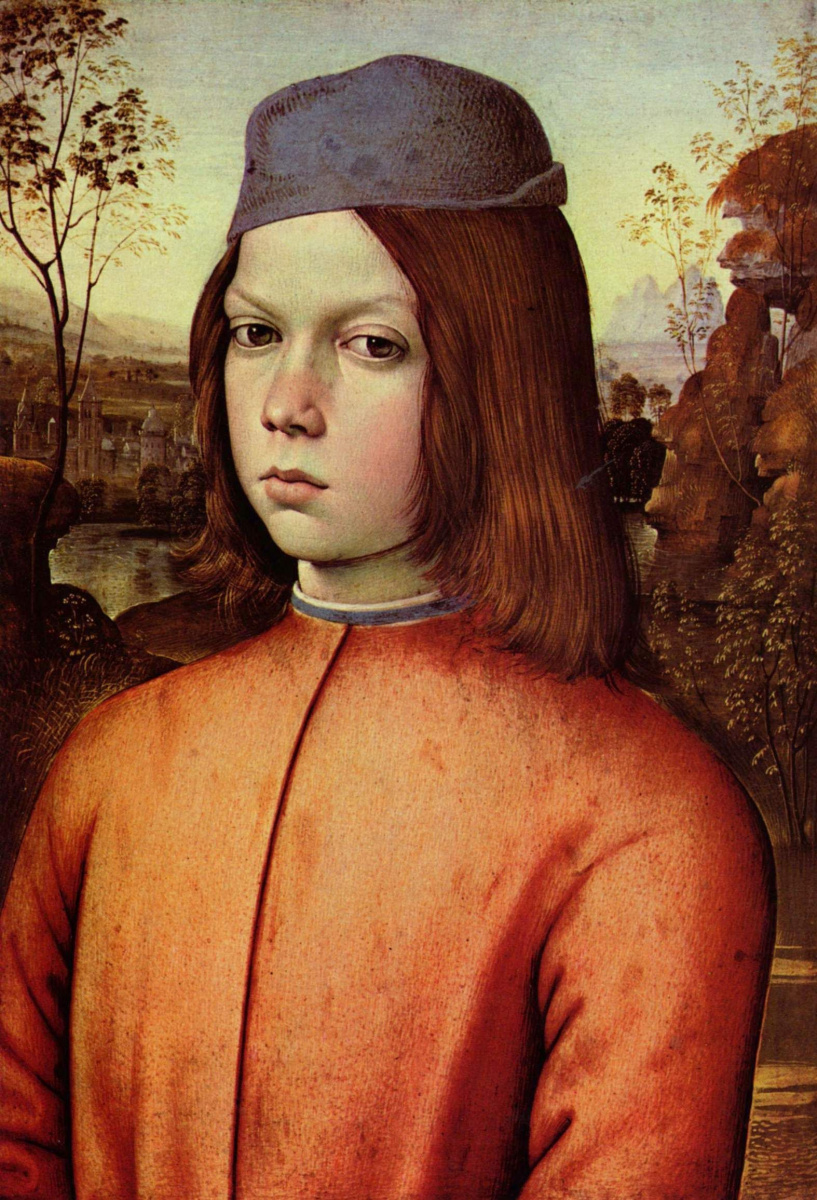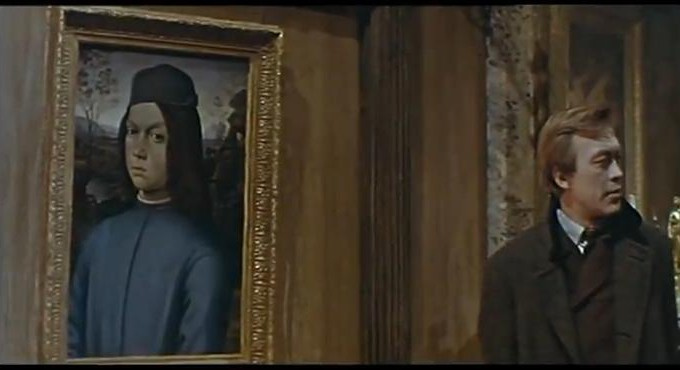log in
Enter site
Login to use Arthive functionality to the maximum
Portrait of a boy
Pinturicchio • Malerei, 1500, 35×28 cm
Bildbeschreibung «Portrait of a boy»
The Italian Pinturicchio known more for his monumental painting, and "Portrait of a boy" one of the few known easel paintings by the artist. In this "Portrait" is perhaps the most remarkable piece of his legacy of those that have survived to the present day.
A picture is associated a curious oddity. In the popular movie "property of the Republic" (1971, directed by Vladimir Bychkov, with Andrei Mironov in the title role) the plot is built around search, the unique collection of paintings of Prince tikhvinski, disappeared during the Civil war in Russia. Among other values, there was a portrait of a "Boy in blue" the brush of Pinturicchio. When the picture appears in the frame you can see "portrait of a boy", but only the coat at this point, not terracotta, as in the original, and somehow blue.
Unfortunately, information about why the filmmakers decided to repaint the masterpiece of the Italian, have not survived. Perhaps in this way they decided to make a tribute to all the famous portraits of the boys in blue, of which the global Fund abound. It "Blue boy" Thomas Gainsborough, and "the boy in the blue coat" Modigliani (1, 2), "Boy with a pipe" Picasso and others. And, of course, the fact that the boy in terracotta viewers could see in one piece, in the Dresden gallery, but the "Boy in blue" Pinturicchio was not seen and never - to empathize with his quest much easier.
As for the present, a true "Boy" Pinturicchio, he rather insular is among other works of the artist. Besides the fact that it's one of his rare easel paintings, it has a number of significant differences. First, the Italian wrote not so much portraits. His main subjects were religious painting (in his "portfolio" means, among other things, the Sistine chapel in the Vatican). Many orders he received from eminent contemporaries, which created epic stories based on their biographies (the most famous of them was Pope Pius II, in the world Aeneas Piccolomini).
Who is depicted on the canvas, and for that he was honored to be captured by the brush of the artist, who has no shortage of well-paying jobs, history does not know. But in portrait of an unknown Pinturicchio seem to have invested all his talent. Rarely on any of his other films you'll see this attention to the personality and emotional state of man. Much more of the painter architectural elements depicted on them the buildings, the details of the lush robes of his characters, ornaments and patterns.
During the writing of the portrait, in the late 15th century, the representatives of the Umbrian school to which they belonged Pinturicchio, pick up the Dutch tendency to rip models from the closed interior of the context and position them on the outdoor infinity background. Moreover, they did not seek to truthfully convey the landscape, but wrote it with the expectation that landscape composite was consistent with the human figure, creating scenery, shading and balance typical of the period naturalism in the depiction of personality traits.
In comparison with the traditional Pinturicchio compositional structure here we are witnessing an almost ascetic minimalism in how discharged the clothes and the background landscape behind him. Pinturicchio was not his habit to overload the picture with lots of detail and lots of small parts, and through this emerges even more clearly the diversity of shades of emotions playing on the face of the hero.
Wittingly or not, the artist caught the boy at a momentous period of his life when he is making an important and inevitable transition from childhood to adolescence. The outlines of his face had not yet lost its childish puffiness, the skin does not have time to harden, not even a hint at the first youth bloom. The fact that the viewer is no longer a child, get a grown-up, sensible look. In this nascent teenage ambition with the upcoming arrogance, does not recognize the authority of the adult world. And awakening awareness of themselves as individuals, a statement admitted as a full existence needs to consider their opinions, desires and will.
Somewhat naive manner in which is written the boy's face, highlighting the contrast between how he is developing physically and mentally: the viewer sees that the body does not have time for mind, as often happens in this age. And the hero portrait as if seeking to neutralize this discrepancy, in dapper hat sliding to one side and keeping a confident posture. Maybe that's why so focused his eyes and a little tense posture: he seriously approached the task of posing the Maestro. But thanks to this whole "portrait of a boy" is completely devoid of static: he's worried, he's breathing, he's alive.
Author: Natalia Azarenka
A picture is associated a curious oddity. In the popular movie "property of the Republic" (1971, directed by Vladimir Bychkov, with Andrei Mironov in the title role) the plot is built around search, the unique collection of paintings of Prince tikhvinski, disappeared during the Civil war in Russia. Among other values, there was a portrait of a "Boy in blue" the brush of Pinturicchio. When the picture appears in the frame you can see "portrait of a boy", but only the coat at this point, not terracotta, as in the original, and somehow blue.
Unfortunately, information about why the filmmakers decided to repaint the masterpiece of the Italian, have not survived. Perhaps in this way they decided to make a tribute to all the famous portraits of the boys in blue, of which the global Fund abound. It "Blue boy" Thomas Gainsborough, and "the boy in the blue coat" Modigliani (1, 2), "Boy with a pipe" Picasso and others. And, of course, the fact that the boy in terracotta viewers could see in one piece, in the Dresden gallery, but the "Boy in blue" Pinturicchio was not seen and never - to empathize with his quest much easier.
As for the present, a true "Boy" Pinturicchio, he rather insular is among other works of the artist. Besides the fact that it's one of his rare easel paintings, it has a number of significant differences. First, the Italian wrote not so much portraits. His main subjects were religious painting (in his "portfolio" means, among other things, the Sistine chapel in the Vatican). Many orders he received from eminent contemporaries, which created epic stories based on their biographies (the most famous of them was Pope Pius II, in the world Aeneas Piccolomini).
Who is depicted on the canvas, and for that he was honored to be captured by the brush of the artist, who has no shortage of well-paying jobs, history does not know. But in portrait of an unknown Pinturicchio seem to have invested all his talent. Rarely on any of his other films you'll see this attention to the personality and emotional state of man. Much more of the painter architectural elements depicted on them the buildings, the details of the lush robes of his characters, ornaments and patterns.
During the writing of the portrait, in the late 15th century, the representatives of the Umbrian school to which they belonged Pinturicchio, pick up the Dutch tendency to rip models from the closed interior of the context and position them on the outdoor infinity background. Moreover, they did not seek to truthfully convey the landscape, but wrote it with the expectation that landscape composite was consistent with the human figure, creating scenery, shading and balance typical of the period naturalism in the depiction of personality traits.
In comparison with the traditional Pinturicchio compositional structure here we are witnessing an almost ascetic minimalism in how discharged the clothes and the background landscape behind him. Pinturicchio was not his habit to overload the picture with lots of detail and lots of small parts, and through this emerges even more clearly the diversity of shades of emotions playing on the face of the hero.
Wittingly or not, the artist caught the boy at a momentous period of his life when he is making an important and inevitable transition from childhood to adolescence. The outlines of his face had not yet lost its childish puffiness, the skin does not have time to harden, not even a hint at the first youth bloom. The fact that the viewer is no longer a child, get a grown-up, sensible look. In this nascent teenage ambition with the upcoming arrogance, does not recognize the authority of the adult world. And awakening awareness of themselves as individuals, a statement admitted as a full existence needs to consider their opinions, desires and will.
Somewhat naive manner in which is written the boy's face, highlighting the contrast between how he is developing physically and mentally: the viewer sees that the body does not have time for mind, as often happens in this age. And the hero portrait as if seeking to neutralize this discrepancy, in dapper hat sliding to one side and keeping a confident posture. Maybe that's why so focused his eyes and a little tense posture: he seriously approached the task of posing the Maestro. But thanks to this whole "portrait of a boy" is completely devoid of static: he's worried, he's breathing, he's alive.
Author: Natalia Azarenka




